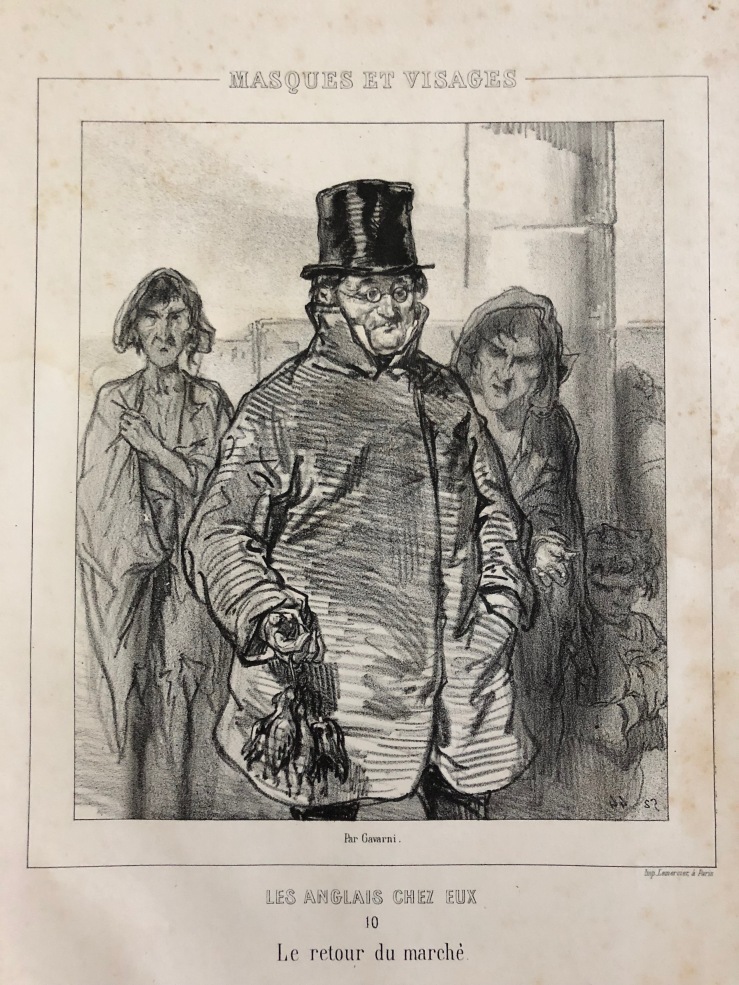Yesterday I saw for the first time this group of prints made by Paul Gavarni (1804-1866), published as a series in 1856, and part of a bigger group of ‘masks and faces’ that were published in L’Illustration in 1852 (volume 19). They give a savage and scathing commentary on the social and economic divisions in nineteenth-century England and Scotland, many of them played out through food and drink.*

I was particularly taken by this image of a portly gentleman carrying home his clutch of tiny game birds—plover? pigeon?—and the haunted, starving faces of the women and child flanking him. He almost entirely fills the frame, and yet they are the ones that overpower it. The more I look at it, the more they claim my attention. It makes me think of Charles Fourier’s impassioned critique of the gastronomes of the earlier years of the same century, feasting as others starve. These tiny birds are clearly one small element of this gastronome’s dinner-to-come, and presumably an expensive one, as he has purchased them himself. Their minute size, especially against his girth, brilliantly emphasises the contrast between the people’s lives; the birds are almost unnoticeable, so that on first glance, the image wouldn’t seem to have anything to do with the market. We see the image, and reading the caption makes us hunt for the food. As we focus on the birds, the hollow-cheeked spectres emerge from the background. The bland understatement (almost misdirection) of the caption directs us to the main point of this image—to remind us that poverty-stricken people must endlessly hunt for enough to eat in a modern urban economy almost literally filled with others who are able to eat only for pleasure, to whom they are wilfully invisible.
I wasn’t aware of Gavarni or his work until I visited Silverman Galleries in Alexandria, VA, yesterday, but it looks as if his is another rich seam of imagery for people thinking about the politics of food—and drink. My colleague acquired two different prints in the series, depicting gin and beer drinkers, respectively. It seems too good a coincidence that Gavarni’s visit to the UK was almost exactly 100 years after Hogarth published Gin Lane and Beer Street, and that his engravings depict depressingly similar themes. These iniquities and their relationship with food and drink has not gone away, and I’ve been trying to think about who the equivalent artists might be for the following century, and for now. So far, Martin Parr has come to mind, but there must be more. Any ideas?
*many of the prints (especially the fabulous beer and gin ones in Krysten’s possession) are clearly of scenes and people in Edinburgh, so ‘les Anglais’ should be read as the British more broadly, not just the English.

Interesting,what’s interesting about Gavarni is that of all the printmaker’s working in the 19th century,Gavarni’s depictions of poverty and rampant alcoholism are the most intense. The print here is rather mild in comparison with other such as Le Gin where the women are half naked in tatters and completely overtaken by the effects of alcohol. These prints as with yours were done at the end of Gavarni’s life when he abandons his fashionable depictions of the demi-monde and focuses exclusively on the extreme poverty he saw in London. In some ways similar to Goya’s black paintings and prints done at the end of Goya’s life in exile in Bordeaux. I’m still trying to figure out Gavarni’s late period and this is how I found your blog. Although Linda Nochlin’s book Misère 2018 is an excellent discussion on the depictions of misery in the 19th century, no mention of Gavarni. One speculation I have as to why the poverty in England and London was so intense were the desperately poor Irish fleeing the Irish Potato Famine and coming into England, the English were completely overwhelmed and unprepared for a disaster of such proportions and unfortunately the famine Émigrés were left on the street to fend for themselves as all English relief systems such as workhouses were filled to capacity. What you’re seeing in this print are probably desperately poor famine Émigrés who flooded the English streets,the indifference of the well off man ignoring them was the attitude of many and Gavarni’s trenchant social commentary.
LikeLike
Johnny Miller’s photography covers similar ground in a more ‘macro’ way.
LikeLike
Splendid commentary. See similar work later in words and images: Henry Mayhew, London Labour and London Poor; 1861; in the USA Jacob Riis, How the Other Half Lives, 1890.
LikeLike